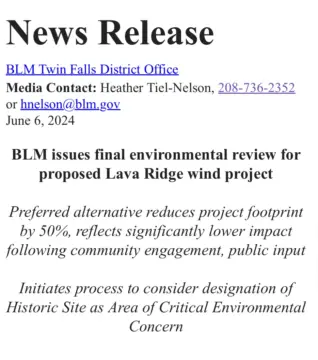
Op-Ed: Lava Ridge vs. Idaho Farmers
By Glenneda Zuiderveld • June 11, 2024Idaho first!!!

As I review my Senate emails, I am receiving numerous messages from farmers in eastern Idaho who have been informed that their water supply will be reduced or completely cut off. Email quote:
“Despite the proactive efforts of the Bingham Ground Water District to procure sufficient storage water to mitigate our share of the predicted shortfall, this mitigation has not been accepted by the Idaho Department of Water Resources. Furthermore, no hearing date has been set by the Idaho Department of Water Resources to consider the mitigation plan submitted almost five months ago.
It is perplexing that this decision is being made by Director Weaver in a year when reservoirs are full, and flood water continues to be released past Milner Dam. The Surface Water Coalition has a collective surplus of over half a million acre-feet of water. Curtailing over 1 million acre-feet of water to address a predicted shortfall of just 74,100 acre-feet for the Twin Falls Canal Company seems excessive and unreasonable, especially considering the inefficiencies in the Twin Falls Canal Company’s canal system, resulting in significant annual water losses.”
This is happening at the same time I received the following press release from the Bureau of Land Management. They state,
“The preferred alternative reduces the area disturbed from the initial proposal by 50 percent, lowers the number of turbines from 400 to 241 to remove the most sensitive locations, and imposes maximum height limits of 660 feet for turbines (instead of 700 feet).”
I have to wonder if this was not Magic Valley Energy’s goal all along. Why would they be okay with fifty percent less revenue? I am still a firm NO, especially now that our Idaho farmers are being told their water will be curtailed.

TWIN FALLS, Idaho–At almost half of the project’s originally proposed size, the BLM’s preferred alternative was shaped by public input and meetings, listening sessions, and significant engagement with local landowners and ranchers, Tribal Nations, federal, state and county elected leaders, interested organizations, the BLM’s Resource Advisory Council for the area, and the National Park Service. The preferred alternative reduces the area disturbed from the initial proposal by 50 percent, lowers the number of turbines from 400 to 241 to remove the most sensitive locations, and imposes maximum height limits of 660 feet for turbines.
Images to indicate the scale of the original proposal, as well as preferred alternative, as viewed from the Minidoka National Historic Site can be found on here.
The BLM will continue to work closely with the company, stakeholders and the community to ensure a final decision minimizes impacts and protects sensitive resources, including through consideration of additional, broader compensatory mitigation measures. Government-to-Government consultation with Tribes is also ongoing.
The preferred alternative adjusts the corridor configuration such that the closest turbine to the Minidoka National Historic Site would be nine miles away, helping to preserve the visitor experience of the remote nature of the former incarceration site for Japanese Americans during WWII. The preferred alternative also reduces potential impacts to sage grouse, large wildlife migration routes and winter concentration areas, cultural resources, Jerome County Airport and agricultural aviation uses, public land ranchers, and adjacent private landowners. Preferred alternative requirements to reduce impacts include seasonal restrictions during construction, private property setbacks, and ensuring the developer coordinates activities with the ranching community. Pursuant to the direction in section 441 of the Consolidated Appropriations Act of 2024 (P.L. 118-42), the BLM has and will continue to engage with Native American Tribes, state and local government officials, cooperating agencies, stakeholders and interested parties. The feedback from these meetings was carefully considered and helped shape the preferred alternative.
In addition, the BLM is responding to a nomination for protection of the landscape’s importance to the Minidoka National Historic Site by putting in place interim measures to protect the cultural resources found in the former Minidoka War Relocation Center on approximately 15,000 acres of public lands surrounding the national historic site. The measures will stay in place until the area is considered for designation as an Area of Critical Environmental Concern during a formal planning process.
The project—proposed by Magic Valley Energy, LLC, an affiliate of LS Power—would create up to 700 jobs during its three-year construction and 20 permanent jobs once it becomes operational. Under the preferred alternative if selected, the project’s construction is estimated to generate $21.9 million in annual tax revenue and contribute $138.9 million in total economic output to local and regional economies. Once in operation, the labor, materials, and taxes are estimated to have a minimum economic output of $7.5 million annually.
The BLM published the Draft EIS in January 2023 for a 90-day comment period. The FEIS will publish in the Federal Register tomorrow and will be followed by a Record of Decision.
Recently, the Department of the Interior announced the BLM had achieved the major milestone of permitting 25 gigawatts of clean energy projects, including solar, wind, geothermal, and gen-ties (transmission lines that cross public lands to connect renewable energy projects on private lands to the grid). The BLM is currently processing 67 utility-scale onshore clean energy projects proposed on public lands in the western United States, which have the combined potential to add more than 31,000 megawatts of renewable energy to the western electric grid. BLM is also undertaking the preliminary review of nearly 190 applications for solar and wind development, as well as 88 applications for wind and solar energy testing.
The BLM manages vast stretches of public lands with the potential to make significant contributions to the nation’s renewable energy portfolio and provides sites for environmentally sound renewable energy projects. Efficient deployment of renewable energy from our nation’s public lands is crucial in achieving the Biden-Harris administration’s goal of a carbon pollution-free power sector by 2035.
The associated documents are available on the BLM National NEPA Register. For more information, please contact Project Manager Kasey Prestwich at BL**************@bl*.gov or 208-732-7204.
-BLM-
The BLM manages more than 245 million acres of public land located primarily in 12 western states, including Alaska, on behalf of the American people. The BLM also administers 700 million acres of sub-surface mineral estate throughout the nation. Our mission is to sustain the health, diversity, and productivity of America’s public lands for the use and enjoyment of present and future generations.
Why would Idaho take on a project that will consume millions of gallons of water and potentially harm our aquifer, which extends all the way to Yellowstone? Why are they prioritizing another state’s energy crisis over the needs of our farmers and ranchers?
I can’t scream this loud enough, “every federal dollar we take we lose local control.”
It is time we prioritize Idaho first and tell the federal government to get out of our business and focus on their primary responsibilities, which include protecting our borders and stopping the invasion of illegal immigration.
This Op-Ed was submitted by Idaho Senator Glenneda Zuiderveld and was originally published on her Substack. Op-Eds do not necessarily reflect the views and opinions of those at the Idaho Dispatch.
Tags: Biden-Harris administration, Bingham Ground Water District, BLM, Bureau of Land Management, Department of the Interior, Director Weaver, Federal money, FEIS, final environmental impact statement, Idaho Department of Water Resources, Idaho Farmers, Lava Ridge, LS Power, Magic Valley Energy, Minidoka, Minidoka National Historic Site, Minidoka War Relocation Center, NEPA Register, Renewable Energy, Twin Falls, Twin Falls County, Water, Wind
4 thoughts on “Op-Ed: Lava Ridge vs. Idaho Farmers”
Comments are closed.








Thanks for coming out green and yellow, that way we know your not red.
I have no idea what your comment means?
Thank you Senator Z. Idaho farmers lose, California wins the water and electricity production war and with this federal expansion thru BLM. In addition, where are the animal protection and bird lover protests?
What about the loss access by the citizens to these “public lands, Grazing leases lost. The Department of Interior has overstepped States rights by these continual land grabs. The push to breach 3 dams on the Snake will cost Idaho increased electricity charge, and decrease the production of electricity by the CLEANEST method there is. I can make no sense of this plan other than the elimination of the middle class.
There is an enemy destroying this nation and our lives and it isn’t Russia China North Korea or Iran.